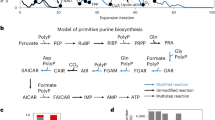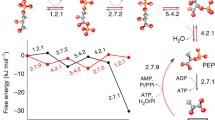Summary
The primitiveness of contemporary fatty acid biosynthesis was evaluated by using the thermodynamics and kinetics of its component reactions to estimate the extent of its dependence on powerful and selective catalysis by enzymes. Since this analysis indicated that the modern pathway is not primitive because it requires sophisticated enzymatic catalysis, we here propose an alternative pathway of primitive fatty acid synthesis that uses glycolaldehyde as a substrate. In contrast to the modern pathway, this primitive pathway is not dependent on an exogenous source of phosphoanhydride energy (ATP). Furthermore, the chemical spontaneity of its reactions suggests that it could have been readily catalyzed by the rudimentary biocatalysts available at an early stage in the origin of life.
Similar content being viewed by others
References
Alborz M, Douglas, KT, Rullo GR, Yaggi NF (1982) Malonycoenzyme A models. Part 2. The methylene deprotonation step of the E1 cB acyl transfer of malonic acid thiolmonoesters. J Chem Soc Perkin Trans 2:1681–1687
Bender ML, Bergeron RJ, Komiyama M (1984) The bioorganic chemistry of enzymatic catalysis. Wiley, New York
Beytia ED, Porter JW (1976) Biochemistry of polyisoprenoid biosynthesis. In: Snell EE (ed) Annual review of biochemistry, vol 45. Annual Reviews, Palo Alto CA, p 113
Borowska Z, Mauzerall D (1988) Photoreduction of carbon dioxide by aqueous ferrous ion: an alternative to the strongly reducing atmosphere for the chemical origin of life. Proc Natl Acad Sci USA 85:6577–6580
Broda E (1971) The evolution of bioenergetic processes. In: Butler JAV, Noble D (eds) Progress in biophysics and molecular biology, vol 21. Pergamon, New York, p 145
Bruice TC, Benkovic SJ (1966a) Bioorganic mechanisms, vol 1. Benjamin, New York, p 259
Bruice TC, Benkovic SJ (1966b) Bioorganic mechanisms, vol 2. Benjamin, New York, p 181
Busca G, Lamotte J, Lavalley J, Lorenzelli V (1987) FT-IR study of the adsorption and transformation of formaldehyde on oxide surfaces. J Am Chem Soc 109:5197–5202
Buvet R, Le Port L (1973) Non-enzymatic origin of the metabolism. Space Life Sci 4:434–447
Caplow M (1965) Studies of the mechanism of biotin catalysis. J Am Chem Soc 87:5447–5785
Clarke PH, Elsden SR (1980) The earliest catabolic pathways. J Mol Evol 15:333–338
Douglas KT (1986) Elimination-addition pathways for thiol esters. Acc Chem Res 19:186–192
Eakin RE (1963) An approach to the evolution of metabolism. Proc Natl Acad Sci USA 49:360–366
Eichberg J, Sherwood E, Epps DE, Oró J (1977) Cyanamide mediated syntheses under plausible primitive earth conditions. IV. The synthesis of acylglycerols. J Mol Evol 10:221–230
Epps DE, Sherwood E, Eichberg J, Oró J (1978) Cyanamide mediated syntheses under plausible prebiotic conditions. V. The synthesis of phosphatidic acids. J Mol Evol 11:279–292
Epps DE, Nooner DW, Eichberg J, Sherwood E, Oró J (1979) Cyanamide mediated synthesis under plausible primitive conditions. VI. The synthesis of glycerol and glycerophosphates. J Mol Evol 14:235–241
Feather MS, Harris JF (1973) Dehydration reactions of carbohydrates. In: Tipson RS, Horton D (eds) Advances in carbohydrate chemistry and biochemistry, vol 28. Academic Press, New York, p 161
Fedoronko M, Konigstein J (1969) Kinetics of mutual isomerization of trioses and their dehydration to methylglyoxal. Collect Czech Chem Commun 34:3881–3894
Feingold DS, Hoffee PA (1972) Other deoxy sugar aldolases. In: Boyer PD (ed) The enzymes, ed 3, vol VII. Academic Press, New York, p 303
Fluharty AL (1974) Biochemistry of the thiol group. In: Pata S (ed) The chemistry of the thiol group, part 1. Wiley, London, p 589
Fouquet G, Merger F, Platz R (1979) Über die Tischtschenkoreaction von aldolen. Justus Liebigs Ann Chem 1591–1601
Forsen S, Nilsson (1970) Enolization. In: Zabicky J (ed) The chemistry of the carbonyl group, vol 2. Interscience, New York, p 157
Gabel NW, Ponnamperuma C (1967) Model for origin of monosaccharides. Nature (London) 216:453–454
Gehring U, Lynen F (1972) Thiolase. In: Boyer PD (ed) The enzymes, ed 3, vol 7. Academic Press, New York, p 391
Getoff N, Scholes G, Weiss J (1960) Reduction of carbon dioxide in aqueous solutions under the influence of radiation. Tetrahedron Lett 17–23
Hall SS, Doweyko AM, Jordan F (1978) Glyoxalase I enzyme studies. 4. General base catalyzed enediol proton transfer rearrangement of methyl- and phenylglyoxalglutathionylhemithiol acetal to S-lactoyl and S-mandeloyglutathione followed by hydrolysis. A model for the glyoxalase enzyme system. J Am Chem Soc 100:5934–5939
Harsch G, Harsch M, Bauer H, Voelter W (1983) Produktverteilung und mechanismus der gesamtreaktion der formosereaktion. Z Naturforsch Teil B 38:1269–1280
Harsch G, Bauer H, Voelter W (1984) Kinetik, katalyse und mechanismus der sekundarreaktion in der schlussphase der formose-reaktion. Justus Liebigs Ann Chem 623–635
Hartman H (1975) Speculations on the origin and evolution of metabolism. J Mol Evol 4:359–370
Hauge JG (1956) On the mechanism of dehydrogenation of fatty acyl derivatives of coenzyme A. IV. Kinetic studies. J Am Chem Soc 78:5266–5272
Higgins MJP, Kornblatt JA, Rudney H (1972) Acyl-CoA ligases. In: Boyer PD (ed) The enzymes, ed 3, vol VII. Academic Press, New York, p 407
Jencks WP (1969a) Catalysis in chemistry and enzymology, chapter 5. McGraw-Hill, New York, p 282
Jencks WP (1969b) Catalysis in chemistry and enzymology, chapter 1. McGraw-Hill, New York, p 7
Jencks WP (1975) Binding energy, specificity, and enzymatic catalysis: the circle effect. In: Meister A (ed) Advances in enzymology, vol 43. Wiley, New York, p 219
Jencks WP (1976) Free energies of hydrolysis and decarboxylation. In: Fasman GD (ed) Handbook of biochemistry and molecular biology, ed 3. Physical and chemical data, vol 1. CRC Press, Cleveland, p 296
Jones WJ, Nagle DP, Whitman WB (1987) Methanogens and the diversity of archaebacteria. Microbiol Rev 51:135–177
Keinan E, Greenspoon N (1989) Reduction of α,β-unsaturated carbonyl compounds. In: Patai S (ed) The chemistry of enones. Wiley, New York, p 923
Knappe J (1970) Mechanism of biotin action. In: Snell EE (ed) Annual review of biochemistry, vol 39. Annual Reviews, Palo Alto CA, p 757
Knowles JR (1989) The mechanism of biotin-dependent enzymes. In: Richardson CC (ed) Annual review of biochemistry, vol 58. Annual Reviews, Palo Alto CA, p 195
Kobuke Y, Yoshida J (1978) Decarboxylative acylation of thiolmalonate. A model for the biosynthesis of fatty acids and polyketides. Tetrahedron Lett 367–370
Koningsberger VV, Overbeek JTG (1955) The hydrolysis and aminolysis of ethyl thioacetate. III. Rate constants at 25°C, activation energies and probability factors. Koninkl Ned Acad Wetenschap Proc, Ser B 58:49–55
Krampitz LO (1969) Catalytic functions of thiamine diphosphate. In: Snell EE (ed) Annual review of biochemistry, vol 38. Annual Reviews, Palo Alto CA, p 213
Lindstrom LA (1979) Formation and further reaction of 3-deoxytetrulose during treatment of (1→4)-linked xylose oligomers with alkali. Carbohydr Res 69:269–271
Loach PA (1976) Oxidation-reduction potentials, absorbance bands and molar absorbance of compounds used in biochemical studies. In: Fasman GD (ed) Handbook of biochemistry and molecualr biology, ed 3, vol 1. CRC Press, Cleveland, p 122
Lynen F, Wieland O (1955) β-Ketoreductase. In: Colowick SP, Kaplan NO (eds) Methods in enzymology, vol 1. Academic Press, New York, p 566
Malmstrom BG (1961) Hydration and dehydration (survey). In: Boyer PD, Lardy H, Myrback K (eds) The enzymes, ed 2, vol 5. Academic Press, New York, p 455
Miller SL (1957) The formation of organic compounds on the primitive Earth. Ann NY Acad Sci 69:260–275
Moss J, Lane MD (1971) The biotin-dependent enzymes. In: Meister A (ed) Advances in enzymology, vol 35. Interscience, New York, p 321
Miziorko HM (1985) 3-Hydroxy-3-methylglutaryl-CoA synthase from chicken liver. In: Colowick SP, Kaplan NO (eds) Methods in enzymology, vol 110, part A. Academic Press, New York, p 19
Mizuno T, Weiss AH (1974) Synthesis and utilization of formose sugars. In: Tipson RS, Horton D (eds) Advances in carbohydrate chemistry and biochemistry, vol 29. Academic Press, New York, p 173
Nooner DW, Oró J (1979) Synthesis of fatty acids by a closed system Fischer-Tropsch process. In: Kugler EL, Steffgen FW (eds) Hydrocarbon synthesis from carbon monoxide and hydrogen. Advances in chemistry series, no. 178. American Chemical Society, Washington DC, p 159
Ogita T, Knowles JR (1988) On the intermediacy of carboxyphosphate in biotin-dependent carboxylations. Biochemistry 27:8028–8033
Page MI (1977) Entropy, binding energy, and enzymatic catalysis. Angew Chem Int Ed Engl 16:449–459
Patai S (ed) (1966) The chemistry of the carbonyl group. Interscience, New York
Pigman W, Anet EFLJ (1972) Mutarotations and actions of acids and bases. In: Pigman W, Horton D (eds) The carbohydrates, vol 1A. Academic Press, New York, p 165
Pinto JP, Gladstone GR, Yung YL (1980) Photochemical production of formaldehyde in earth's primitive atmosphere. Science 210:183–185
Porter JW, Spurgeon SL (eds) (1981) Biosynthesis of isoprenoid compounds. Wiley, New York
Poulter D, Rilling HC (1981) Prenyl transferases and isomerase. In: Porter JW, Spurgeon SL (eds) Biosynthesis of isoprenoid compounds, vol 1. Wiley, New York, p 161
Qureshi N, Porter JW (1981) Conversion of acetyl-coenzyme A to isopentenyl pyrophosphate. In: Porter JW, Spurgeon SL (eds) Biosynthesis of isoprenoid compounds, vol 1. Wiley, New York, p 47
Rao M, Eichberg J, Oró J (1987) Synthesis of phosphatidylethanolamine under possible primitive earth conditions. J Mol Evol 25:1–6
Rastetter WH, Adams J (1981) α-Keto acid dehydrogenases: a chemical model. J Org Chem 46:1882–1887
Reid C, Orgel LE (1967) Synthesis of sugars in potentially prebiotic conditions. Nature 216:455
Sauers CK, Jencks WP, Groh S (1975) The alcohol-bicarbonate-water system. Structure-reactivity studies on the equilibria for formation of alkyl monocarbonates and on the rates of their decomposition in aqueous alkali. J Am Chem Soc 97:5546–5553
Sellin S, Mannervik B (1983) Reversal of the reaction catalyzed by glyoxalase 1. Calculation of the equilibrium constant for the enzymatic reaction. J Biol Chem 258:8872–8875
Shinkai S, Hamada H, Kusano Y, Manabe O (1979) Coenzyme models. Part 16. Studies of general-acid catalysis in the NADH model reduction. J Chem Soc Perkin Trans 2, 699–702
Speck JC (1958) The Lobry de Bruyn-Alberda van Ekenstein transformation. In: Wolfrom ML (ed) Advances in carbohydrate chemistry, vol 13. Academic Press, New York, p 63
Stern JR (1961) Crotonase. In: Boyer PD, Lardy H, Myrback K (eds) The enzymes, ed 2, vol 5. Academic Press, New York, p 511
Tanford C (1980) The hydrophobic effect: formation of micelles and biological membranes. Wiley, New York
Theander O (1962) Dicarbonyl carbohydrates. In: Wolfrom ML, Tipson RS (eds) Advances in carbohydrate chemistry, vol 17. Academic Press, New York, p 223
Thauer RK, Jungermann K, Decker K (1977) Energy conservation in chemotrophic anaerobic bacteria. Bacteriol Rev 41: 100–180
Tilley BF, Porter DW, Gracy RW (1973) Metal-ion catalysis of aldose-ketose isomerizations in acidic solutions. Carbohydr Res 27:289–296
Vander Jagt DL, Daub E, Krohn JA, Han LB (1975) Effects of pH and thiols on the kinetics of yeast glyoxalase 1. An evaluation of the random pathway mechanism. Biochemistry 14: 3669–3675
Weber AL (1981) Formation of pyrophosphate, tripolyphosphate, and phosphorylimidazole with the thioester, N,S-diacetylcysteine, as the condensing agent. J Mol Evol 18:24–29
Weber AL (1984) Nonenzymatic formation of “energy-rich” lactoyl and glyceroyl thioesters from glyceraldehyde and a thiol. J Mol Evol 20:157–166
Weber AL (1985) Alanine synthesis from glyceraldehyde and ammonium ion in aqueous solution. J Mol Evol 21:351–355
Weber AL (1987) The triose model: glyceraldehyde as a source of energy and monomers for prebiotic condensation reactions. Origins Life 17:107–119
Weber AL, Hsu V (1990) Energy-rich glyceric acid oxygen esters: implications for the origin of glycolysis. Origins Life 20: 145–150
Wheeler OH (1966) Reduction of carbonyl groups. In: Patai S (ed) The chemistry of the carbonyl group. Interscience, London, p 507
Wilson GE, Hess A (1980) Acylation of thiol ester enolate anions. J Org Chem 45:2766–2772
Zabicky J (ed) (1970) The chemistry of the carbonyl group, vol 2. Interscience, New York
Zubay G (1983) Biochemistry, chapter 13. Addison-Wesley, Reading MA, p 471
Author information
Authors and Affiliations
Rights and permissions
About this article
Cite this article
Weber, A.L. Origin of fatty acid synthesis: Thermodynamics and kinetics of reaction pathways. J Mol Evol 32, 93–100 (1991). https://doi.org/10.1007/BF02515381
Received:
Revised:
Accepted:
Issue Date:
DOI: https://doi.org/10.1007/BF02515381




